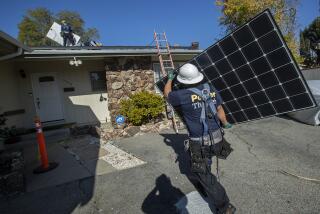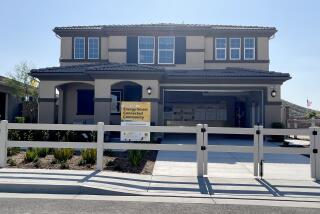Energy-efficient homes seem to sell faster, fetch higher prices
- Share via
Home energy efficiency and sustainability have been major policy priorities for the Obama administration, but lurking in the background are two consistent questions: Beyond the documentable savings on utility bills, do such steps add to the resale value of a home? And do they make it easier or faster to sell your property?
Housing groups and housing officials say that definitive statistical data covering multiple regions of the country are scarce. But some localized research projects in Oregon, Washington and California offer promising hints.
In a study covering existing and new houses sold from May 2010 through April of this year, the Earth Advantage Institute, a nonprofit group based in Portland, Ore., found that newly constructed homes with third-party certifications for sustainability and energy efficiency sold for 8% more on average than noncertified homes in the six-county Portland metropolitan area. Existing houses with certifications sold for 30% more.
The raw sales data in the study were provided by the Portland Regional Multiple Listing Service. “Certified” houses were defined as those carrying Energy Star or LEED for Homes designations or Earth Advantage home certifications. (LEED stands for Leadership in Energy and Environmental Design.) The latest study was the fourth in an annual series conducted by Earth Advantage, each of which has shown clear price premiums for certified houses.
But officials caution that using average sales prices pulled from MLS data without trying to measure “comparable” homes against one another directly may not be conclusive. For instance, newly constructed certified houses may be more expensive to start, and existing certified homes may be larger and more likely to be in higher-cost neighborhoods where homeowner adoption rates for energy-efficiency measures are higher.
Nonetheless, said Dakota Gale, Earth Advantage’s manager of sustainable finance, looking back at four years of studies, “we can still see a consistent trend that third-party certification continues to result in a higher sales price, even during the past year when home sales were down.”
A study conducted two years ago by the institute in Seattle and Portland identified what may be another plus: Homes marketed with energy-efficiency certifications appear to sell faster on average than those without. The study tried to come up with rough comparability in appraisal terms between certified and noncertified properties, and it found that in Portland, certified homes spent 18 days less time on the market after listing than noncertified counterparts. In both Portland and Seattle, researchers documented price premiums — 9.6% in Seattle, 4.2% in Portland — in a statistical analysis with a 95% confidence level.
A recent study on houses in San Diego and Sacramento published by the National Bureau of Economic Research took a different tack: When you install photovoltaic solar panels on your roof, how much do you get back in market resale terms, beyond monthly energy savings?
Researchers examined a sample of home sales in the $500,000 range in both metropolitan areas between 2003 and 2010 and found that, on average, solar panel installations cost owners $35,967. But with federal and state subsidies, the net average cost came down to $20,892. This net expenditure, in turn, yielded an increase in appraised value by $20,194 — a 97% rate of recovery on the investment.
Though less than 100%, the rate is much higher than most home improvements in the most recent “Cost vs. Value” study conducted by Remodeling magazine — well above major kitchen and bathroom renovations.
Kevin Morrow, senior program manager for green building at the National Assn. of Home Builders, says that although many newly constructed homes come with energy and sustainability certifications, banks don’t necessarily recognize their value when it comes to providing mortgage money.
For example, bank underwriters often do not include reduced monthly utility costs in the household income/household expense ratios that affect the maximum mortgage amounts available to buyers.
“The case needs to be made” to lenders, he said, “that, hey, these houses will cost less to operate, so they should be worth more.”
Morrow added that appraisers are part of the issue as well if they don’t have the training to recognize and credit extra value to houses that have money-saving solar installations, geothermal heating and cooling, Energy Star appliances, water conservation features and other green improvements.
The Appraisal Institute, the largest group representing that industry, says it has sponsored “green” appraisal courses for 2,300 appraisers during the last two years. It says it strongly supports efforts to better incorporate energy and environmental factors into mortgage underwriting and home valuations, including a possible congressional mandate requiring it.
Distributed by Washington Post Writers Group.
More to Read
Inside the business of entertainment
The Wide Shot brings you news, analysis and insights on everything from streaming wars to production — and what it all means for the future.
You may occasionally receive promotional content from the Los Angeles Times.










